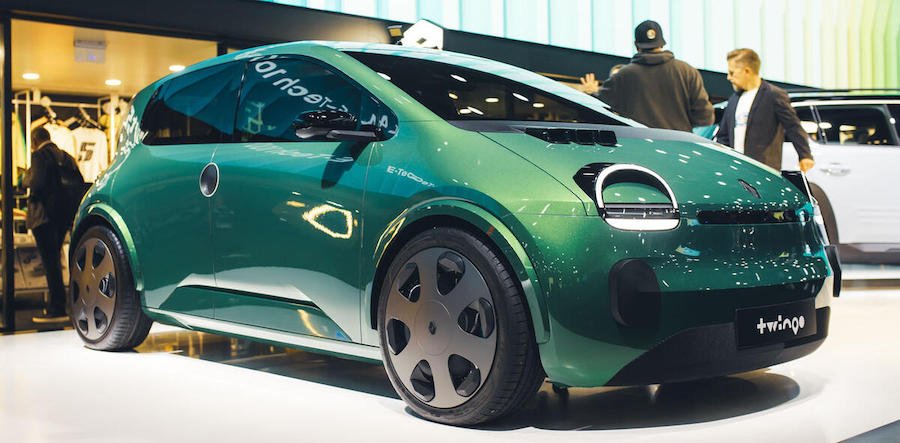Renault Group CEO Luca de Meo “wants” to make the reborn Renault Twingo in right-hand-drive but admitted making the business case to do so was “a challenge”.
The new electric city car, which is based on the French firm's new Ampr Small EV platform, will go on sale in left-hand-drive markets in 2026, priced from less than €20,000.
De Meo echoed the comments of other senior Renault executives recently at the Paris motor show, who told Autocar that while the Twingo was engineered for RHD, the firm still “needed to find a business case”.
The clincher could be a deal with Nissan, which is in talks with Renault to build its own city car derived from the Twingo, much like it's using the new Renault 5 EV as basis for the next Nissan Micra, which will be engineered and built by Renault.
“In the case of the Renault 5, we had the Nissan Micra and they wanted right-hand drive. So [a RHD Twingo] could be shared with the Japanese. When they want the wheel on the other side too, it becomes less complicated,” said de Meo.
More broadly on electrification, de Meo lamented a lost decade for electric cars in Europe in the 2010s that is only now being recovered with more desirable “emotional cars” like the 5.
He's not concerned about stalling demand for EVs but believes he has that covered off anyway with an investment in hybrids that has put Renault at number two in Europe for such cars, after Toyota.
“Tesla started [in the early 2010s with EVs]; we all started. We all got darts; we all stopped. Tesla continued, and now look at what it’s worth.
“EVs might not be 100% of car sales in Europe in 2035, but for city cars and last-mile delivery products, on cost and performance they make more sense than internal-combustion models – and that’s the speciality of our house.
“That’s why it was so important for us to do a bespoke B-segment platform for EVs [Ampr Small], and that’s our home turf. We need to keep going. The way to get there [mainstream acceptance of EVs] is making them affordable, with good performance and nice looks.
“But we’re not only going to do EVs.”
De Meo was dismissive of suggestions that the likes of the 5, Renault 4 and Twingo were retro designs; and said that the likes of the Rafale, Symbioz and Scenic, all also created on his watch, show that Renault isn't a one-trick pony.
If you say the cars are retro, then “the [Volkswagen] Golf is a retro design, the [Mercedes-Benz] S-Class is a retro design," countered de Meo. "We’ve just taken some of the classic designs and spirit and moved them into the 21st century."
His suggestion is that the only difference between a Golf and a 5 of the same original era and now was the gap in production inbetween for the latter model.
“Great brands nurture their classics,” he said, adding that friendlier, more relatable styling was even more important for EVs “as we know how difficult the transition is”.
“We [the industry] all did some strange, funky EVs, just to show that they were different. The [Nissan] Leaf, the [Volkswagen] ID 3. Our aesthetics are now reassuring. A Renault 5 is a Renault 5 that’s also an EV; the Twingo as well. They help facilitate the transition to EVs.”
Data shown by Renault brand CEO Fabrice Cambolive showed the instant impact the 5 had had to Renault’s EV sales in France. The brand's market share moved from 16.1% between January and October to 16.8% in November, the 5's first full month on sale, while its EV share grew from 16.3% to 23.2%.
“27% of orders have been in bright yellow, which shows people want to stand out and have fun in this car,” Cambolive said, noting that Renault desires the 5 to become the brand's Mini.
Renault CTO Philippe Krief said the firm now had an opportunity to be more innovative in some of the technology it offers on its cars, specifically its EVs.
He said: “The technology base is there and the team is good. We just need to move out of our comfort zone, even on the management side. It won’t be easy, but there will be examples.”
The latter comment was a reference to potential limited-series models Renault could use as technology showcases.
There remains plenty that can be done to improve the efficiency of electric drivetrains as well as aerodynamic efficiency, Krief said, while developments in battery chemistry could be more quickly integrated into cars than before, down from around five years to two years.
On broader battery technology, de Meo said he didn't expect to see solid-state batteries in mainstream EVs until the 2030s and described the technology as “extremely complex”.
He also said that there would need to be huge changes to car development and factories to accommodate the technology, which could further extend the life of existing battery technologies, such as LFP and NMC.
To that end, he said, “when you’ve invested billions in plants, you need to amortise those investments” anyway.
Related News



